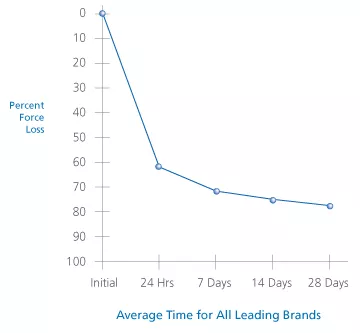Clinical Abstracts and Studies
- Frictional Forces
- Comparison of Maxillary Arch
- Self-Ligating vs. Conventional Brackets
- Damon System vs. Conventional Appliances
- Comparison of Resistance to Sliding
- Self-Ligating Treatment
- Treatment Time
- Self-Ligating in The Year 2000
- Interactive Edgewise Mechanisms
- Force Decay and Deformation
- Ligature Wires and Elastomeric Rings
Force Decay and Deformation of Orthodontic Elastomeric Ligatures
Taloumis LJ, Smith TM, Hondrum SO, and Lorton L. American Journal of Orthodontics & Dentofacial Orthopedics 1997; 111:1-11.
Objective
For all leading brands, evaluate force decay, dimensional change, and permanent deformation of molded elastomeric ligatures in a simulated oral environment.
Methodology
Initial wall thickness, inside diameter, outside diameter, and force levels of each ligature were measured. Three of four test groups of ligatures were stretched over stainless steel dowels with a circumference approximating that of a large orthodontic twin bracket. Test group one was kept at room temperature and humidity for 28 days and test group two to four in synthetic saliva baths at 37°C, pH 6.84. The residual forces and dimensional changes were measured. Force levels were tested at 28 days for test group two and at 24 hours, 7 days, 14 days, and 28 days for test group three. The fourth test group of unstretched samples was measured to evaluate dimensional changes due solely to moisture absorption at 28 days.
Results
Elastomeric ligatures deform permanently when stretched and within just 24 hours exhibit force loss of up to 68%.

Permanent Deformation of Elastomeric Ligatures
Conclusion
The rapid force loss and permanent deformation of these products may preclude their use for rotational and torque corrections.